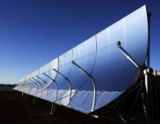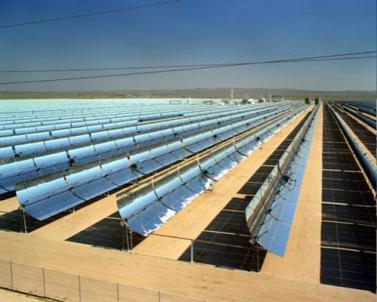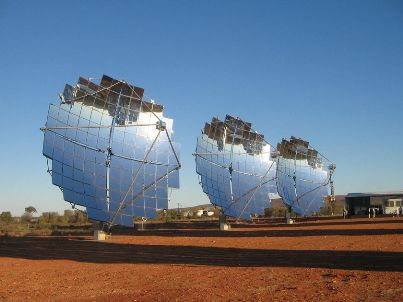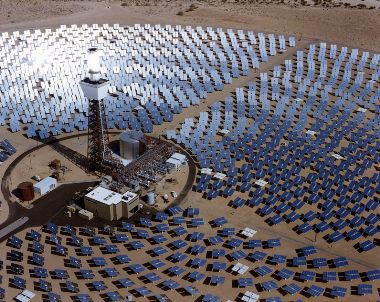Solar concentrators
 Basically, solar concentrators are very different from photovoltaic converters… In addition, thermal-type solar power plants are much more efficient than photovoltaics due to a number of characteristics.
Basically, solar concentrators are very different from photovoltaic converters… In addition, thermal-type solar power plants are much more efficient than photovoltaics due to a number of characteristics.
The task of the solar concentrator is to focus the sun's rays onto a container of cooling liquid, which can be for example oil or water, which are good at absorbing solar energy. Concentrating methods are different: parabolic cylindrical concentrators, parabolic mirrors or heliocentric towers.
In some concentrators, the solar radiation is focused along the focal line, in others — at the focal point where the receiver is located. When solar radiation is reflected from a larger surface to a smaller surface (the surface of the receiver), a high temperature is reached, the coolant absorbs the heat, moving through the receiver. The system as a whole also contains a storage part and an energy transfer system.
The efficiency of concentrators is significantly reduced during cloudy periods, as only direct solar radiation is focused.For this reason, these systems achieve the highest efficiency in regions where the level of insolation is particularly high: in deserts, in the equatorial region. In order to increase the efficiency of the use of solar radiation, the concentrators are equipped with special trackers, tracking systems that ensure the most accurate orientation of the concentrators in the direction of the sun.
Because the cost of solar concentrators is high and the tracking systems require periodic maintenance, their use is mainly limited to industrial power generation systems.
Such installations can be used in hybrid systems together, for example, with hydrocarbon fuel, then the storage system will reduce the cost of produced electricity. This will become possible as the generation will be done around the clock.

Parabolic tube solar concentrators are up to 50 meters long, resembling an elongated mirror parabola. Such a concentrator consists of a set of concave mirrors, each of which collects parallel rays of the sun and focuses them on a specific point. Along such a parabola, a tube with a cooling liquid is located, so that all the rays reflected by the mirrors are focused on it. To reduce heat loss, the tube is surrounded by a glass tube that extends along the focal line of the cylinder.
These hubs are arranged in rows in a north-south direction and are certainly equipped with solar tracking systems. The radiation focused in the line heats the coolant to almost 400 degrees, it passes through the heat exchangers, generating steam that turns the turbine of the generator.
In fairness, it should be noted that a photocell can also be located in place of the tube. However, despite the fact that the concentrator sizes can be smaller with photovoltaic cells, this is fraught with a decrease in efficiency and the problem of overheating, which requires the development of a high-quality cooling system.
In the California desert in the 1980s, 9 power plants of parabolic cylindrical concentrators with a total capacity of 354 MW were built. Then the same company (Luz International) also built a SEGS I hybrid installation in Deget, with a capacity of 13.8 MW, which additionally included natural gas ovens. In general, by 1990, the company had built hybrid power plants with a total capacity of 80 MW.
The development of solar energy production in parabolic power plants is being carried out in Morocco, Mexico, Algeria and other developing countries with funding from the World Bank.
As a result, experts conclude that today, parabolic trough power plants lag behind both tower and disk solar power plants in terms of profitability and efficiency.

Disk solar installations — these are, like satellite dishes, parabolic mirrors that focus the sun's rays onto a receiver located at the focus of each such dish. At the same time, the temperature of the coolant with this heating technology reaches 1000 degrees. The heat transfer fluid is immediately fed to a generator or engine which is combined with a receiver. Here, for example, Stirling and Brighton engines are used, which can significantly increase the performance of such systems, since the optical efficiency is high and the initial costs are low.
The world record for efficiency of a parabolic dish solar installation is 29% thermal-to-electrical efficiency achieved by a dish-type installation combined with a Stirling engine at Rancho Mirage.
Due to the modular design, match type solar systems are very promising, they allow you to easily achieve the required power levels for both hybrid users connected to public electricity grids and independent. An example is the STEP project, which consists of 114 parabolic mirrors with a diameter of 7 meters located in the state of Georgia.
The system produces medium, low and high pressure steam. The low-pressure steam is supplied to the air-conditioning system of the knitting factory, the medium-pressure steam is supplied to the knitting industry itself, and the high-pressure steam is supplied directly to generate electricity.
Of course, solar disc concentrators combined with a Stirling engine are of interest to the owners of large energy companies. Thus, Science Applications International Corporation, in collaboration with three energy companies, is developing a system using a Stirling engine and parabolic mirrors that will be able to produce 25 kW of electricity.

In tower-type solar power plants with a central receiver, solar radiation is focused on the receiver, which is located at the top of the tower…. A large number of reflectors-heliostats are placed around the towers... The heliostats are equipped with a two-axis sun tracking system, thanks to which they always turn so that the rays are stationary, concentrated on the heat receiver.
The receiver absorbs heat energy, which then turns the turbine of the generator.
The liquid coolant circulating in the receiver carries the steam to the heat accumulator. Usually works are water vapor with a temperature of 550 degrees, air and other gaseous substances with a temperature of up to 1000 degrees, organic liquids with a low boiling point - below 100 degrees, as well as liquid metal - up to 800 degrees.
Depending on the purpose of the station, the steam can turn a turbine to generate electricity or be directly used in some kind of production. The temperature in the receiver varies from 538 to 1482 degrees.
The Solar One power tower in Southern California, one of the first of its kind, originally produced electricity through a steam-water system producing 10 MW. Then it underwent modernization and the improved receiver, now working with molten salts and the heat storage system, became significantly more efficient.
This led to a breakthrough in solar concentrator technology for battery tower power plants: power in such a power plant can be produced on demand, as the heat storage system can store heat for up to 13 hours.
Molten salt technology makes it possible to store solar heat at 550 degrees, and electricity can now be produced at any time of the day and in any weather. Tower station "Solar Two" with a capacity of 10 MW has become a prototype of industrial power plants of this type. In the future — the construction of industrial enterprises with a capacity of 30 to 200 MW for large industrial enterprises.
The prospects are colossal, but development is hindered by the need for large areas and the significant costs of building tower stations on an industrial scale. For example, to place a 100 megawatt tower station, 200 hectares are required, while a nuclear power plant capable of producing 1,000 megawatts of electricity requires only 50 hectares. Parabolic-cylindrical stations (modular type) for small capacities, on the other hand, are more cost-effective than tower ones.
Thus, tower and parabolic trough concentrators are suitable for power plants from 30 MW to 200 MW that are connected to the grid. Modular disk hubs are suitable for autonomous powering of networks that require only a few megawatts. Both tower and slab systems are expensive to manufacture but give very high efficiency.
As you can see, parabolic trough concentrators occupy an optimal position as the most promising solar concentrator technology for the coming years.
Also read on this topic: Development of solar energy in the world
